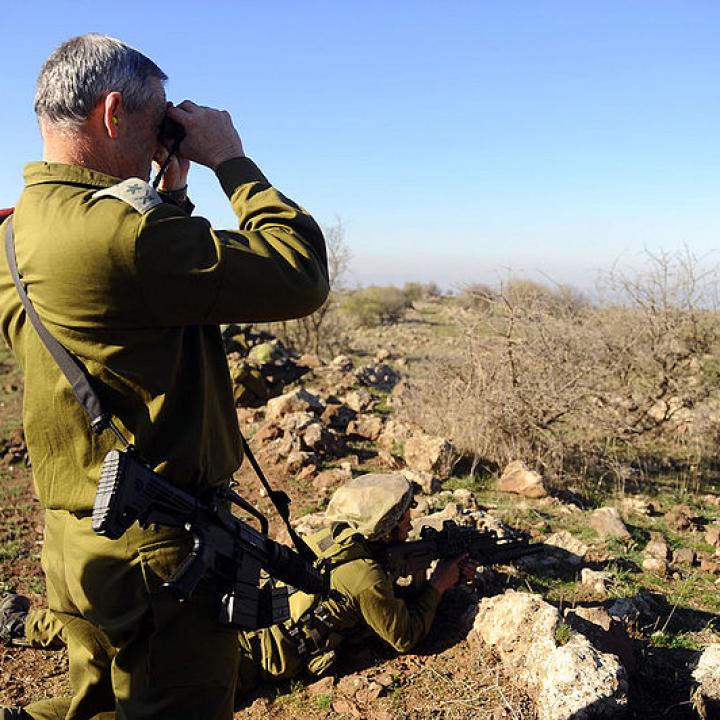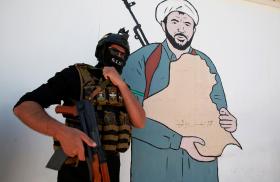
- Policy Analysis
- Fikra Forum
A Strengthening Shiite Axis Paradoxically Gives Peace between Syria and Israel a Chance

As the Assad-Iran-Russian axis prepares for the "last battle in Idlib," the question arises: what does the ‘day after’ look like for the region when events in Syria finally come to a conclusion?
It is clear that Iran’s proxy forces would prefer to create a new Syria in accordance with their strategic interests, yet there is a clear point of contention between Iranian expansionist policies and the other regional and international powers’ interests in the country. Russia would prefer to see a political arrangement between all involved parties; Assad intends to focus on rebuilding a Syria completely under his control; and Saudi and Israeli foreign interests are dedicated to preventing the realization of Iran’s intentions in the region.
With Iran’s intentions diametrically opposed to those of other regional actors, the question of which vision for the region will win out is undecided. Thus, it is the influence of international forces—namely Russia and the United States—that holds the key to the future of Syria and the extent of Iran’s role in it.
It is clear that Russia has committed itself to playing a direct role in stabilizing Syria, but the United States’ future role is less certain. However, one unrecognized aspect of this major conflict is that the U.S. administration is now being presented with a major opportunity to work towards its larger goals in the Middle East—the twin interests of regional stability and containment of Iran—through a well-timed, multi-lateral political arrangement between Syria and Israel, two neighbors whose geopolitical animosity has complicated regional security for decades.
More specifically, reaching an agreement between the Syrian and Israeli governments regarding the Golan Heights would both provide a new solution to an old problem and prevent new complications from arising. Iran, through its Quds Force proxy militias and Hezbollah, is in the process of transforming sections of southern Syria into a new front against Israel by acclimating ground troops while also strategically amassing and delivering guided-missiles there.
Israel has aimed to draw a red line at Iranian involvement in Syria ‘at all costs,’ clearly demonstrated through its decisive action against most of the known Iranian infrastructure in Syria during 2018. As neither side appears willing to back down, and as Russian S-300 missile systems are being deployed to the area, the threat of escalation between Iran and Israel has never been higher. By drawing Russian and Syrian interests to the south through a settlement on the Golan Heights, further escalation with Iran and its proxy forces may be mitigated.
Peace through International Actors
Paradoxically, Israeli-Iranian tension may make many of the involved actors in the Israel-Syria conflict more willing to negotiate through third party actors. Trump’s success in promoting peace talks in the Korean Peninsula and his strong pushback against Iran both augur well for a presidential initiative on an Israel-Syria peace plan, which would also involve negotiations with autocrats in order to achieve a larger geostrategic goal.
The flexibility of other negotiators in acting against Iran is more significant than it appears at first glance. Russia became involved in the Syrian conflict in order to protect its strategic assets, re-establish its long lost status in the region by defying the United States, and rally its people around Putin following the annexation of the Crimea. Going forward, Russia is likely to be interested in a political arrangement that will subdue Sunnis' motivation to continue the fight, provide international legitimacy for its long-term military presence in Syria, reduce the economic burden of its participation in the Syrian war, and potentially ease Western sanctions on Russia.
While the United States Congress is unlikely to allow for full normalization of relations with Russia given the other outstanding tensions between the countries, presidents Trump and Putin may find a point of agreement in their mutual interest in stabilizing Syria through negotiations. Were Russia and the United States to work together on a negotiations plan between Israel and Syria, this channel of communication may have the added benefit of further constructive collaboration elsewhere, suggesting that this plan would be constructive on both a regional and an international level.
To frame a Syria-Israel arrangement, Russia and the United States could endorse a ‘land-for-money’ formula, coupled with Israel’s withdrawal from several key areas in the Golan Heights. Syria would be compensated for the remaining areas officially annexed by Israel for a substantial amount to be agreed upon in advance. Funds, expected to be in the tens of billions, will emanate from both Israel and deal partners, and must be utilized for the reconstruction of Syria. A substantial portion of the proceeds from the Golan Heights purchase can also be used to fund reconstruction efforts to be managed by U.S., Russian, and European companies.
Under this model, Israel would accept a UN Security Council resolution formally ending the conflict. Syria and its backers will need to agree to a comprehensive demilitarization agreement to ensure security along the new border.
As for Russia, it will receive an international mandate to remain in Syria, with either U.S. or NATO forces present to ensure correct implementation of the agreement between the parties and to maintain security after the war ends. Russia could agree to restrict its military presence in Syria to the port of Tartus and the Hmeimim airbase.In return, all negotiating parties would commit to an agreed plan to dismantle the Iranian and Hezbollah military presence in Syria, shifting the complicated situation in Syria to a more straightforward collection of interests aligned against continued Iranian expansion.
The Benefits of Compromise
While both sides would be making significant compromises, there are also a number of benefits for all involved parties unique to the current geopolitical environment. An international agreement concerning the Golan Heights would provide greater stability on the Syria-Israel border, while Israel’s payment for the remainder of territory occupied would provide Syria with access to much needed funds for the reconstruction of Syria. Indeed, under combined threat of Russian, U.S., and Israeli pressure, Iran and Hezbollah would most likely leave Syria at the request of the new Syrian government.
It should be noted that in light of Putin’s role in assisting Syrian forces during its civil war, although Assad is currently on the winning side, it is evident that Russia could replace Assad were its interests so aligned. Assad appears aware of this reality, and will presumably accept new political agreements presented as a means to ensure his hold on his own territory.
Israel’s political establishment may be unusually receptive to a settlement, especially one promoted by both the United States and Russia. Prime Minister Benjamin Netanyahu, who continues to face political challenges in the domestic arena linked to his corruption investigations, will be delighted to advance the success of a political solution which involves removing Iranian presence from Syria, all the more so in light of the upcoming 2019 Israeli legislative elections. The promotion of a ‘land-for-money’ formula is also neatly aligned with the Israeli right’s political narrative.
Along with the realization of the territories in exchange for money formula, Israel's limited withdrawal from sections of particular territories, and in particular the Shaaba Farms area, may create additional cracks in the Shiite axis narrative. Today, Hezbollah presents the farms—which are claimed as territory by both Lebanon and Syria but occupied by Israel since 1967—as a major pretext for its struggle against Israel. Hezbollah, which characterizes their aggression against Israel as participating in a territorial dispute between Israel and Lebanon, will lose a significant talking point once Israel withdraws from these areas of conflict.
And while normalization with Israel has also traditionally been a point of contention for other Arab states, it is less likely that other Arab states would make serious objections to an agreement at the current moment. Egypt is working on building closer ties with Russia, while Saudi Arabia and its gulf partners are increasingly presenting Israel as a strategic partner against a larger Iranian threat.
Establishing a secure and normalized border inthe Golan region as part of a peaceful settlement of the Syrian civil war could significantly reduce military tensions both between Israel and Syria, and among regional and global powers in the Middle East.
Indeed, the proposed ‘land-for-money’ formula may not only allow for formal reconciliation between Israel and Syria but also prove useful for the resolution of other regional conflicts, such as the Israeli-Palestinian conflict. Ending the conflict between Israel and Syria could serve as a first step in a broader reconciliation between the Arab World and Israel, providing greater regional structure to a peaceful two-state solution between Israel and the Palestinians.
Setting Syria up with a more stable structure and ample funds for reconstruction is a goal that benefits the broader international community as well. Syrian peace and reconstruction should provide an opportunity for significant refugee resettlement, mitigating adverse financial and societal impacts on Europe, Jordan, Turkey, and Lebanon. In light of this opportunity, both the United States and Russia should seriously consider this approach to one element of Syria’s Gordian knot.

